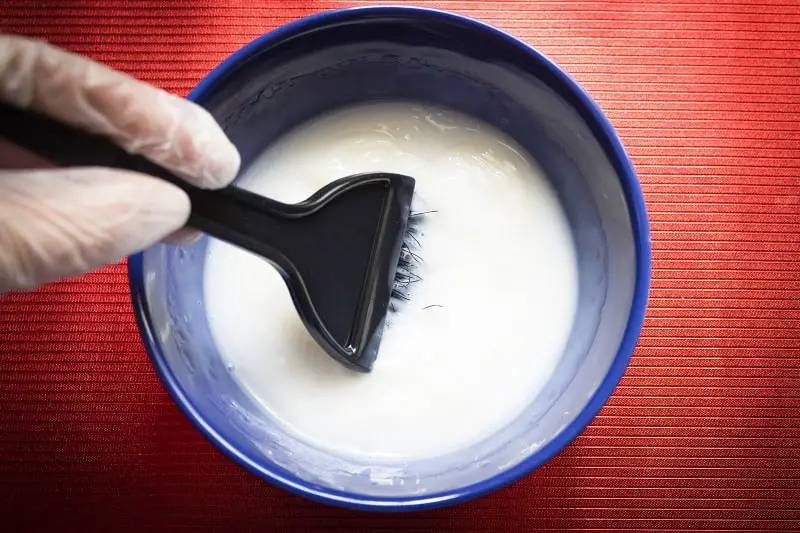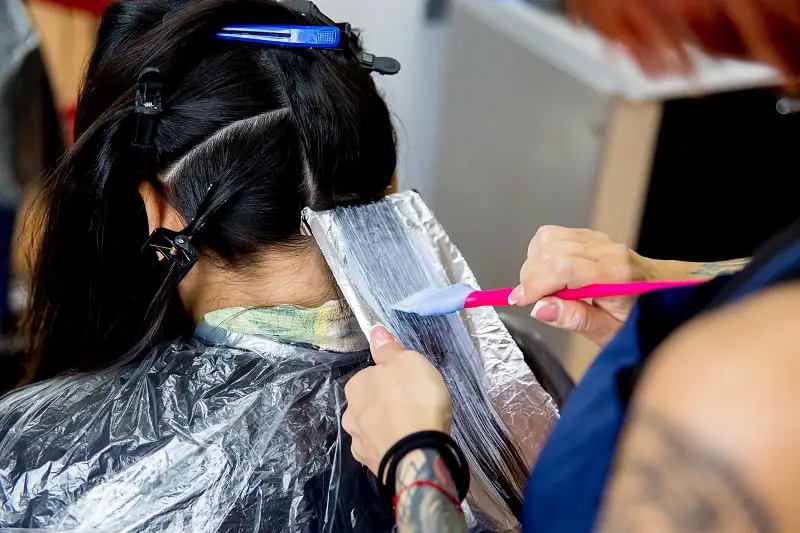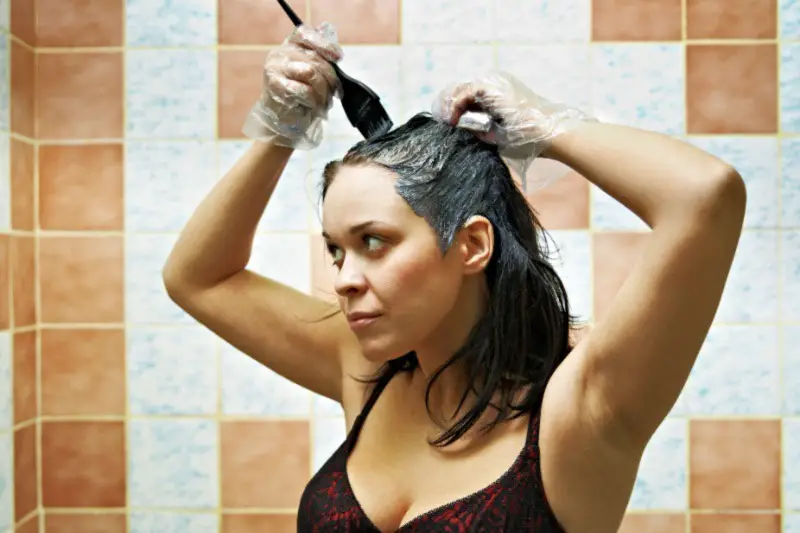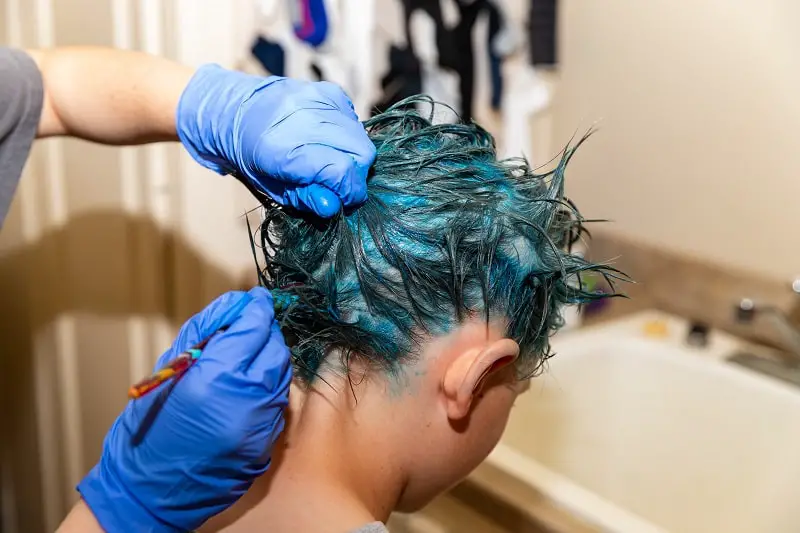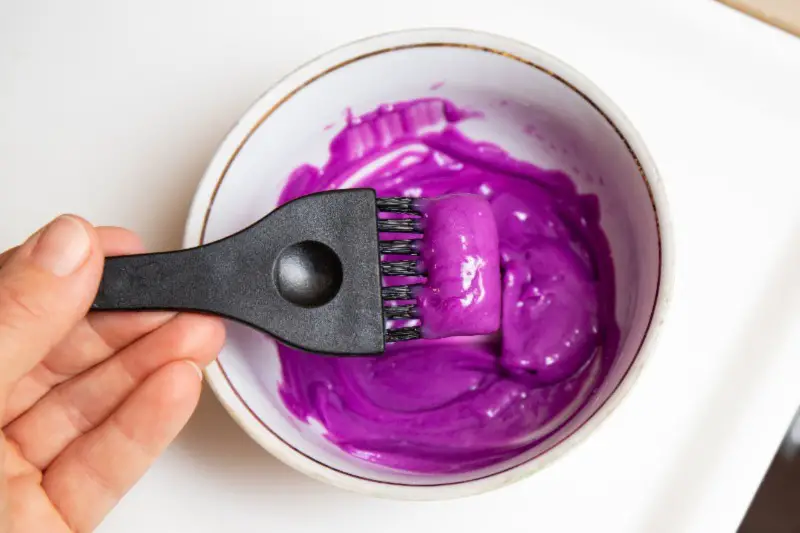Why is hair dye not staying in my hair? Goodness, have we been there! Investing the time and effort into dyeing your hair is absolutely worth it … until you realize that, for some reason or another, the hair dye is not staying in your hair.
You’ve switched up brands, maybe even tried a weird “hack” or two, and still, nothing helps. What gives? Well, the effectiveness of hair dye relies heavily on hair porosity. If your hair cuticle is too closed off, then the dye won’t set as it should.
If your hair cuticle is too open, then your hair dye won’t stay in your hair. This can be a money sink while simultaneously grinding on your nerves. Luckily, there is a way to remedy this.
To find out more about how to approach fast-fading hair dye and high porosity hair, continue reading below. We’ve covered the reasons behind why hair dye isn’t staying in your hair, along with how you can fix it. PSA: it isn’t easy, it isn’t for everyone, but it is so worth it.
Why Is My Hair Not Holding Color?
Your hair is likely not holding color because of the porosity of your hair. Generally, the higher porosity you have, the faster color will fade. Talk about frustrating! We totally get it; beauty is our thing, so we understand how big of a wrench in your plans faded hair dye can be.
The biggest problem with porous hair comes down to color retention. Retention, in this sense, is your hair’s ability to maintain certain levels of absorbed moisture. Hair with high porosity has no problem taking in color.
In fact, it has no problem taking in anything. Water, oil, cream, pigment—you name it. Since high porosity hair functions like an open door system, dyes fade just as fast as they are applied.
High porosity hair is often attributed to past damages. Anything from a bad bleach job, excess use of hot tools, or an ill-fated perm can land you with highly porous hair. A long history of rigorous beauty practices can also wear and tear on your hair.
Now, while this is the case, there are instances of high porosity hair being completely natural. That’s right: you can just be born with it. No strings attached. No past damage. Nada.
Taking this into consideration, you may already be aware of the fact that you have high porosity hair. When you have your head of hair your whole life, you start to learn a thing or two about it.
That being said, instead of looking for a why, you may instead be looking for a solution. As luck would have it, we have some suggestions. The harsh reality is that if you want your hair color to last, you will have to put in extra effort.
High porosity hair is not for the faint of heart. If your hair is not holding color, it may be time to look into using hydrolyzed protein fillers. Hydrolyzed proteins (for your hair) are essentially proteins that have been through a chemical process.
Okay, this may sound like a red flag, but we promise it is not. Hydrolysis, what the proteins go through, is when a compound is broken down after a reaction with water. The process breaks down the protein enough for it to quickly and effectively get to work.
In short, the hydrolysis kicks the protein into gear. Hydrolyzed proteins are usually made out of vegan wheat protein, wool protein, or silk protein. All reinforce the hair cuticle, increasing both luster and moisture retention.
How Do I Get My Hair Color To Stay?
Protein fillers can help your hair color stay. They contain hydrolyzed proteins that can temporarily repair the hair cuticle. In turn, repairing the cuticle will help color retention. Easy-peasy. On that note, keep in mind that protein fillers are not a permanent fix.
If you want to help improve your hair porosity you will need to give it a lot of attention. We’re talking deep conditioning, oil treatments, overnight hair masks—the whole shabang!
Also, giving heat tools a break wouldn’t be a bad idea, regardless of whether or not you use a protectant. Once your hair has had an opportunity to repair itself, your dye should hold much better.
Consequently, if we take into consideration that you’re dealing with high porosity hair, protein fillers are worth the shot. They work great and more importantly, make your hair look and feel marvelous.
Fillers are an especially good option for those with naturally high porosity and have a hair care routine down pat. Again, fillers should be used when you want to retain hair color, but it is only a BAND-AID fix.
It won’t last in the long run unless you take steps to address the bigger issue. As an aside, many protein products include silicones. If you are trying to go silicone-free take extra care when reviewing the ingredients label of a new product.
A highly-rated brand to look out for is Pacifica, which is advertised as being 100% vegan and cruelty-free. They have a Vegan Silk Hydro Luxe Conditioner, but of course, there are other sustainable options.
The main thing to keep in mind is that—if you want your hair color to stay—you need to fix its porosity first. Whatever way you go about it is entirely up to you and what you are trying to accomplish with your hair.
If you just want the dye to stay and don’t otherwise mind your hair, protein fillers may be your preferred option. If you want to make your hair all-around more manageable, you may be in for the long haul.
Will Porous Hair Take Color?
Yes, porous hair will take color. In fact, hair that is of medium porosity will hold color the best. Medium porosity is considered normal. It is thought to be the “happy medium” between high and low porosity.
So, what is the difference between high and low porosity hair? When comparing the two, low porosity hair won’t take color well. Its cuticle is too closed to allow penetration: moisture struggles to reach the strands.
Because of this, hair that is low porosity swings between the extremes of being too dry and too oily. Furthermore, low porosity will make it harder for dyes to adequately saturate your hair. For this reason, you likely won’t end up with the color displayed on the box.
On the other side of things, high porosity hair is no better. Hair that is high in porosity will oftentimes feel crunchy or get tangled easily. Color will fade significantly faster and your hair is prone to absorbing anything that comes its way. It is a very touch-and-go relationship.
Now, this is where porous hair comes in—that is, hair of medium porosity. The cuticle is open just enough to be receptive to dyes and moisturizers without early fading.
Medium porosity hair doesn’t struggle with getting or keeping moisture, unlike the other too porosity types. This makes it, to a degree, more manageable when it comes down to hair care.
If you are unsure about the level of your hair porosity, there are a couple of ways you can go about finding out. The most common way to find out is the water test. The steps are simple. We’ll review them below:
- The first thing you want to do is comb your hair. Most of the time, we shed some strands when we brush (or comb) our hair. Hold on to two or three of these loose strands.
- Next, get a glass of room-temperature water. It doesn’t have to be a full glass—1/3rd of the way full will do just fine.
- Put the strands in the water glass and observe for three minutes. Yep, that’s it.
Now that you’re looking at a cup of water with some hair in it, what does it mean? Well, if the hair floats then you have low porosity hair; if it initially floats and slowly begins to sink, then you have medium porosity; and if the strands start rapidly sinking, your hair is high porosity.
How Do You Fix Porous Hair That Won’t Hold Color?
Fixing porous hair that won’t hold color is an arduous process. There’s no easy way around it. You’ll have to seriously step up your hair care routine. That means adjusting your hair washing schedule, steps, and aftercare.
You may have to switch out products or add in completely new ones. However, it can be done. Hair porosity—even natural porosity—can be adjusted to an extent in either direction. You will just need to know which products to use and what you should avoid.
Porous hair needs a break from curlers, irons, and perms. Avoid blow drying with hot air (a cool air setting should be fine). Moreover, your high porosity hair will appreciate dense, protein-packed moisturizing products.
Extensive deep conditioners, like a protein conditioner, are a plus as well. Just remember that less is more when applying. Also, stick to putting product on your hair from the chin down: anything higher could make your hair look greasy.
We recommend the following products to help improve high porosity hair:
- SheaMoisture High Porosity Moisture Replenish Masque
- SheaMoisture High Porosity Moisture Replenish Shampoo
- SheaMoisture Manuka Honey & Yogurt Hydrate + Repair Protein-Strong Treatment
- Aphogee Serious Care & Protection Two-Step Protein Treatment
- Roux Rejuvenating Porosity Control Corrector & Conditioner
- Eva NYC The Therapy Session Hair Mask
On that note, those with high porosity hair can also benefit from keratin treatments. It is a chemical treatment, so it isn’t for everyone. By now, we are all well aware of formaldehyde content in hair smoothing products.
Whether or not you use a keratin treatment on your hair is entirely up to you and your preferences. Nonetheless, keratin treatments are based on the idea that the cuticle is sealed and smoothed: something high porosity hair needs.
Examples of some keratin treatments include the Brazilian Blowout, Trissola, and Keratin Express. The availability of these could vary depending on your location and the resources your salon has available to them.
Comparatively, an alternative to any of these is a cysteine treatment. A cysteine hair treatment employs the use of non-essential amino acids to achieve a smooth finish. You’ll get the same results as you would with a keratin treatment, minus the chemicals.
Additionally, it is slightly more expensive than standard keratin treatments. Check with your preferred salon to see what options they have available.
Final Thoughts: Why Is Hair Dye Not Staying In My Hair?
Now that we’ve reached the end of the article, let’s review. Hair dye relies on the openness of one’s hair cuticle. This is why developers are used with permanent and demi-permanent hair dyes, to encourage absorption.
Meanwhile, semi-permanent dyes will take your hair however it is at the moment. When a hair cuticle is too open, or when the hair is considered high porosity, then dyes won’t hold well.
Retention is rough and the color fades quickly. It is the opposite of low porosity hair, which struggles with absorbing in the first place. The good news is that there are steps to combat this.
High porosity hair needs more attention (usually) than other porous levels. It requires regular deep-conditioning to help it get moisture. Heat, if possible, should be avoided to stop the cuticle from opening further.
Likewise, protein fillers can help in real time. Using protein fillers during the dyeing process temporarily closes the cuticle, thus allowing color retention.
In all, if you’re stressed out that your hair isn’t keeping color, you aren’t alone. And, it can be helped. A bit of research here, a bit of TLC there, and you’ll have beautifully dyed tresses in no time.
Porous hair is natural and a common occurrence globally. Thanks to its frequency, leading beauty brands have had tons of practice perfecting products. Finding one suited to your hair won’t be as daunting as a challenge as it seems.
Recommended
If you enjoyed reading this article, check out some of our other amazing blog posts:

